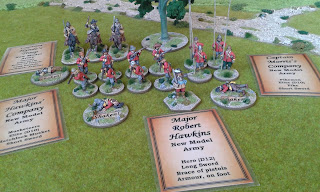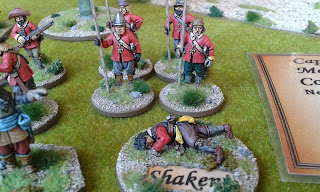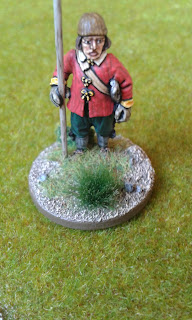First (and last) post of December 2015, and with it comes a run-down of the year's progress, the state of things so far, and musings on 2016. It seems to be a fairly common theme across the wargaming 'blog-osphere' to have such a post, so who am I to buck the trend? I did do an 'end of term' report back in 2013, so it's high time one appeared again, and hopefully this year, things will be more positive at 'Fall on Pell Mell Comprehensive School'! Off we go ...
Painting
Overall, I've enjoyed painting this year, and have seen a much more consistent approach. There's still been the odd 'painters-block' moment, especially burn-out after Partizan, and real life has often taken precedence over the hobby, but the fortnights and months of not picking up a brush for pleasure have given way to only days and weeks this year. Much more positive! I've not really tried any new techniques; I still work from a black undercoat, and use the three colour or triad system. Even so, I have bought some new paints from Foundry, so have a wider palette to use in the future. I've also invested in some painting guides, notably Kevin Dallimore's 'Painting and Modelling Masterclass' from Foundry, and 'Painting Wargaming Figures' by 'El Mercenario' Javier Gomez Valero. I've been impressed by both books so far, and have been a fan of both authors' works for some time. The Foundry guide has many contributions from other notable painters, and has already proved to be a useful mine of tips. El Mercenario might be the person who even pushes me towards trying to use Vallejo paints as well! So, a steady year, and a B grade I think, for my work so far!
Productivity
Here, at least things have been looking up. As I type, there are 37 figures waiting to be finished on the painting desk - all prepped/cleaned up and undercoated, and in various stages of completion, which were started this year. On top of this, I've finished off and based 2 heroes, 4 casualties markers, a dismounted dragoon marker, 13 infantry and dragoon figures, and six mounted figures - a total of 20 'foot' figures and 7 horses and riders! Well into double figures, and certainly the most productive year for a while. I've also finished off lots of scenic bits and bobs - 2 houses, trees, 8 sheep, a goat, rabbits, chickens, barrels, stowage, tents, a standing stone, a campfire, scenic 'humps and hollows'.... fairly productive I reckon! So I'll give myself a B+ on that score - not the best, but certainly travelling in the right direction!
Over the last few days, I've been working on some more foliage, and the final figures for a Scots pike unit for my 'Donnybrook' project. These should make an appearance in early 2016. With this post, I'll have had the most prolific year as far as blogging is concerned (just!), and I've also joined the Lead Adventure Forum, which has spurred me on even more. I've even got some games in this year - admittedly these have been run-throughs of the 'Somewhere in Scotland, 1650' Donnybrook game which we ran at 2015s 'Other Partizan' show last September, but games none the less, and great fun they were! Overall, the last 12 months have been great productivity wise, and I can't wait until next year to carry this on.
Projects
February 2016 sees the two year anniversary of my Donnybrook ECW project, and it's still going strong. I've done nothing else this year, but work on this - some of the items will also do for future projects and 'general' terrain use - but all the effort over the last twelve months has been towards Donnybrook ECW. The highlight of 2015 was, after many years of dreaming, finally putting on a game at the Partizan show in Newark. At some point, I'll write a post about it! Having attended the show at Kelham Hall for many years (since the mid-90's), it was very poignant putting on a game on the occasion of the show having it's last outing at Kelham, before it moves to it's new home of the Newark Showground from 2016.
 |
| The Other Partizan 2015 |
I couldn't have done it without fellow re-enactors and friends John B, Alex and Luke, Neil, Andy and Jez, and many thanks must got to these guys! Cheers to Tricky and Laurence at the Newark Irregulars for allowing us to put on a game. To all those who popped by and said encouraging words, or took part in one of our participation games, heartfelt appreciation to you as well. This goes for all those who have popped by on the blog or on forums as well, and chipped in with supportive comments and feedback. The final and most important thanks, must go to my family and especially my wife, who's supported me so much over the last 12 months - tolerating talking to my back as I sit at the painting desk in the evenings, and when I crawl to bed at 2am having just varnished up another load of figures! Thank you love!
Looking to the future of 'Somewhere in Scotland, 1650', we've been invited back to the new-look Partizan show in 2016, so there's going to be an expanded version of this next May, in time for this. More English, more Scots, more trees, a deer.....maybe even a pig or two.....and definitely some civilians - but no more chickens! Watch this space. Overall, I reckon a B+ on this front as well!
Purchases
Apart from the usual paints and associated modelling paraphernalia, most of my purchases have been for my Donnybrook project. Ainstey castings have seen some of my cash this year, as has Foundry, and The Last Valley for some scenic trees. I picked up some figures and scenery bits and bobs from Colonel Bills, so I'm looking forward to painting these up in the coming weeks. Warbases have also seen a bit of my money, buying up bases for Donnybrook (and future) projects. Literature, in one form or another has been the biggest 'cost' - apart from the painting books (although one of them was a birthday present), I purchased an Osprey book on the Dunbar campaign, and very early in the year, I picked up a copy of 'Chain of Command' from the Too Fat Lardies, and the 'Rebellion' AWI Black Powder supplement from Warlord Games. In terms of regular purchases, I still buy Wargames Illustrated most months, although I prefer Wargames, Soldiers and Strategy, which I also get hold of when it's published. I suppose I've been fairly disciplined with my buying - there's been no other figures that have strayed into my shopping bags, except those for Donnybrook ECW - so I'll give my self a straight C for that one.
2016
So ....... on to the future. The next 12 months will see the 'Rawgamers' put on our expanded Donnybrook ECW game at Partizan, so the first milestone will be at the end of May for that particular project. After that, who knows! It will be the culmination of over 2 years' work, so finishing it off will be a bit strange. I've not decided yet what the next projects will be - I have a few ideas that I'll put forward on this blog in the coming days, but I think they'll be smaller in size. Maybe..... who knows in this hobby? I am clear that I don't want to go back to butterflying about again, between lots of different ideas, so whatever it is, I'll try and stick to it/them again, like I have with this one! Something Mediaeval and 'skirmish-y' seems a possible choice at the moment....
 |
| Minding out for any Rampant Lions?... |
Andy





















































